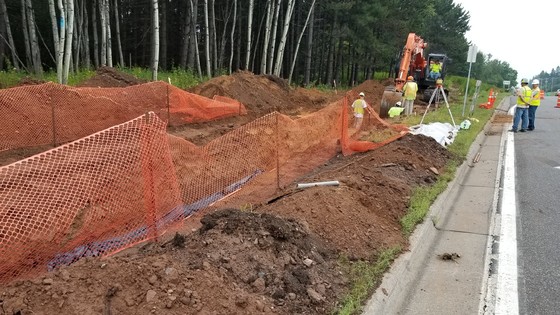NEWS RELEASE
FOR IMMEDIATE RELEASE:
August 27, 2018
MEDIA CONTACT: Steve Krasaway, Resident Engineer
218-625-3841 (office) • 218-213-0579 (cell)
Planned exploratory digging on Arlington Avenue unearths empty coffins, possible human bone
A St. Louis County Public Works crew, while conducting planned archaeological exploratory digging on Arlington Avenue in Duluth in preparation for a future project, has unearthed a series of wood coffins and what appears to be a human bone. The artifacts were found last Wednesday on the east side of Arlington Avenue just south of Arrowhead Road.
The excavation work was being done specifically to check for the possibility of human remains. This is because the location is in close proximity to the Greenwood Cemetery, which served as the burial site for approximately 5,000 people who died at the former St. Louis County Poor Farm between 1891 and 1947.
The State Archaeologist was contacted, who advised the crew to look in the coffins, which revealed them to be empty. The lone bone that was found was located outside of the coffins. The preliminary assumption was that these are remnants from a grave relocation project that took place in the 1960s.
Public Works staff has been working with local archaeologist Susan Mulholland, president and principal investigator with Duluth Archaeology Center, since last year to research the possibility of graves in the area. Ground-penetrating radar has been used and, in instances where anomalies were found, spot excavations were conducted. No coffins or human remains were found through any of these steps. Mulholland was on site during Wednesday's excavation, and continues to assist with the exploratory work.
The Fond du Lac Band and Minnesota Indian Affairs Council also were notified about the discovery of the bone because some of the people buried in the cemetery were of Native American ancestry.
On Friday, State Archaeologist Amanda Gronhovd visited the site and met with Public Works engineers and Mulholland, as well as Melissa Carda of the Minnesota Indian Affairs Council. While it is still believed that the one bone that was found is not part of a full remain, but rather is a remnant from the grave relocations that took place in '60s, the decision was made to further investigate directly in the area where the coffins were located. A team of archaeologists is expected to arrive within a week or two to determine if there are any additional bones. The Minnesota Indian Affairs Council, in collaboration with the State Archaeologist, will coordinate and pay for the additional study.
In the meantime, Public Works, with the assistance of Mulholland, will continue its planned excavation to the south of the site.
"We already had fulfilled requirements for checking for human remains, but out of an abundance of caution we wanted to conduct this additional exploratory excavation," said Steve Krasaway, St. Louis County public works engineer. "Records have indicated that some graves had been relocated from this area many decades ago due to previous road projects. So we felt it was important to take this extra step now out of respect for any potential remains and to ensure we wouldn't make similar discoveries once the project was underway."
The exploratory digging is being done in preparation for a project set for 2020 that involves reconstructing and widening Rice Lake Road north of Arrowhead Road, as well as other improvements to that intersection.
The involved area is currently fenced off, and the public is advised to stay out of the excavation site for both safety reasons and out of respect for the potential of other remains that may still be there.
The Greenwood Cemetery was declared inactive by the County Board in 2012. This was done in recognition of the fact that record keeping at the turn of the century was often inaccurate. Numerous instances had been found of unmarked graves, duplicate grave numbers and general confusion over where particular individuals were buried.
 ###
|